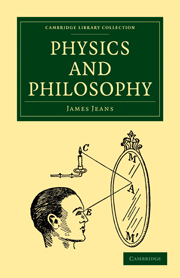Book contents
- Frontmatter
- Contents
- Preface
- I What are Physics and Philosophy?
- II How do we know? (Descartes to Kant; Eddington)
- III The two voices of Science and Philosophy (Plato to the present)
- IV The Passing of the Mechanical Age (Newton to Einstein)
- V The New Physics (Planck, Rutherford, Bohr)
- VI From Appearance to Reality (Bohr, Heisenberg, de Broglie, Schrödinger, Dirac)
- VII Some Problems of Philosophy
- Index
IV - The Passing of the Mechanical Age (Newton to Einstein)
Published online by Cambridge University Press: 07 September 2010
- Frontmatter
- Contents
- Preface
- I What are Physics and Philosophy?
- II How do we know? (Descartes to Kant; Eddington)
- III The two voices of Science and Philosophy (Plato to the present)
- IV The Passing of the Mechanical Age (Newton to Einstein)
- V The New Physics (Planck, Rutherford, Bohr)
- VI From Appearance to Reality (Bohr, Heisenberg, de Broglie, Schrödinger, Dirac)
- VII Some Problems of Philosophy
- Index
Summary
Pre-Newtonian Mechanics
The earliest attempts to discover the pattern of events were limited, naturally enough, to the visible movements of objects either on what we have called the man-sized scale or on the far grander scale of astronomy—these were the only movements which could be studied without instrumental aid.
The movements of the astronomical bodies were treated only in their geometrical aspect. The ‘fixed stars’ hardly came under discussion at all, since they appeared to have no motion beyond their diurnal rotation round the pole. This was of course a consequence of their great distance from the earth, but it was explained by supposing them to be immovably attached to a sphere which rotated round the earth as centre.
There remained the sun, moon, and planets. A whole succession of astronomers—from Aristarchus through Ptolemy to Copernicus and Kepler—had investigated the paths in which these bodies moved, but had shown very little concern as to why they moved in these particular paths rather than in others. Aristotle's pronouncement that a circular motion was natural to all bodies, because the circle was the perfect geometrical figure, seems to have stifled curiosity fairly thoroughly for nearly two thousand years; it was uncritically accepted by Copernicus, and even at one time by Galileo.
It was different with terrestrial bodies; there had been many attempts to explain their movements in what we should now describe as dynamical terms.
- Type
- Chapter
- Information
- Physics and Philosophy , pp. 105 - 125Publisher: Cambridge University PressPrint publication year: 2009First published in: 1942

